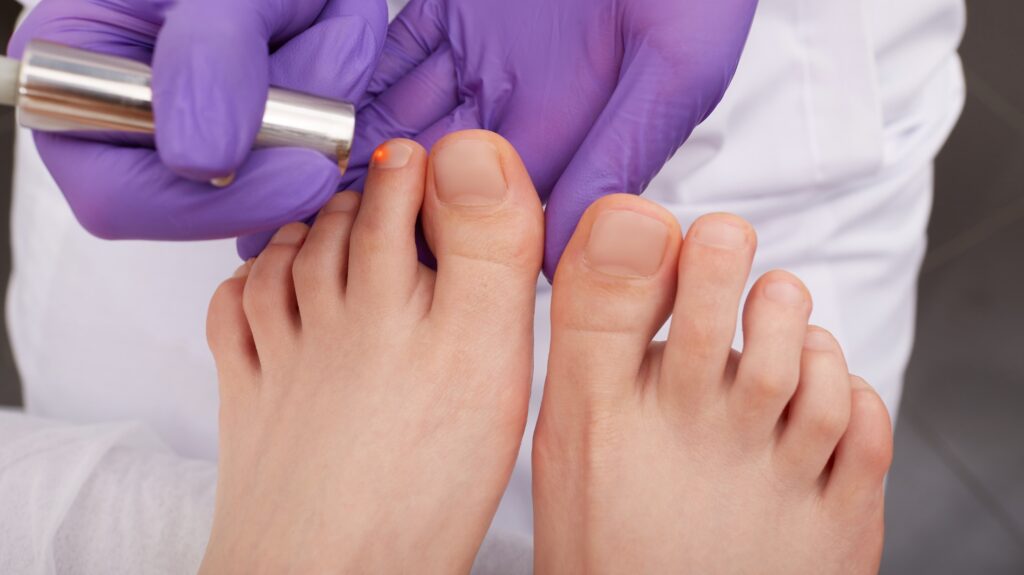Know How to Prevent Foot and Toenail Fungus
This post was last updated on April 9th, 2024

Pedicure and foot care play integral roles in maintaining both the health and aesthetics of the feet. Beyond the cosmetic benefits, regular pedicures contribute to the prevention of common foot problems like ingrown toenails, fungal infections, and calluses. Proper nail trimming and cleaning not only enhance hygiene but also prevent painful conditions. The massaging and moisturizing elements of a pedicure promote improved blood circulation, reducing the risk of issues such as peripheral artery disease. Additionally, these practices contribute to stress relief and relaxation, positively impacting both physical and mental well-being.
For individuals with diabetes, meticulous foot care is essential to prevent complications. Professional pedicures can also aid in the early detection of potential problems, allowing for timely intervention. Moreover, the aesthetic aspect of well-groomed feet enhances overall appearance and contributes to a sense of self-care which is why it is very essential to know how to prevent foot and toenail fungus. Regular foot care, whether done professionally or at home, is a holistic practice that not only maintains foot health but also reflects a commitment to personal hygiene, physical comfort, and an overall sense of well-being.
What are foot and toenail fungus?
Foot and toenail fungus are fungal infections that commonly affect the feet and toenails. These infections are usually caused by dermatophytes, a group of fungi that thrive in warm and moist environments. The two primary types of fungal infections related to the feet and toenails are athlete’s foot (tinea pedis) and toenail fungus (onychomycosis).
- Athlete’s Foot (Tinea Pedis):
- Cause: Athlete’s foot is commonly caused by the fungi Trichophyton, Epidermophyton, or Microsporum.
- Symptoms: It often presents as red, itchy, and peeling skin, particularly between the toes. In severe cases, blisters may develop, and the infection can spread to the soles and sides of the feet.
- Toenail Fungus (Onychomycosis):
- Cause: Toenail fungus is often caused by the same types of fungi responsible for athlete’s foot.
- Symptoms: This infection affects the toenails, leading to discoloration (yellowing or darkening), thickening, and brittleness of the nails. In advanced stages, the nails may become distorted or separated from the nail bed.
Causes and Risk Factors for Foot and Toenail Fungus
Several causes and risk factors increase the likelihood of developing foot and toenail fungus infections. These factors create conditions favorable for the growth and spread of fungi. Common risk factors include:
- Warm and Moist Environments: Fungi, especially dermatophytes responsible for these infections, thrive in warm and moist conditions. Walking barefoot in communal areas like locker rooms, saunas, and swimming pools increases the risk.
- Poor Foot Hygiene: Inadequate foot hygiene, such as not drying the feet thoroughly after bathing or swimming, provides a breeding ground for fungi. Dampness between toes and in shoes contributes to fungal growth.
- Sweaty Feet: Excessive sweating, or hyperhidrosis, can create an environment conducive to fungal infections. It’s more common in individuals who wear closed shoes for extended periods, particularly those made of non-breathable materials.
- Wearing Tight Shoes or Ill-Fitting Footwear: Shoes that are too tight or ill-fitting can cause friction and pressure on the toenails and skin, potentially leading to nail and skin damage that facilitates fungal entry.
- Weakened Immune System: Individuals with compromised immune systems, whether due to medical conditions, medications, or treatments like chemotherapy, are at a higher risk of developing fungal infections.
- Age: As people age, the nails may become more brittle, and blood circulation to the feet may decrease, making older individuals more susceptible to fungal infections.
- Existing Skin Conditions: Certain skin conditions, such as psoriasis or eczema, may create openings in the skin, providing an entry point for fungi.
- Peripheral Arterial Disease (PAD): Reduced blood flow to the extremities, as seen in conditions like PAD, can hinder the body’s ability to combat infections, increasing susceptibility to fungal growth.
- History of Fungal Infections: Individuals with a history of athlete’s foot or toenail fungus are more prone to recurrent infections, which is a solid factor one should know how to prevent foot and toenail fungus.
- Genetic Predisposition: Some individuals may have a genetic predisposition that makes them more susceptible to fungal infections.
- Occupational Factors: Certain occupations that involve prolonged periods of wearing closed shoes, especially in humid or damp environments, can increase the risk of fungal infections.
How to Prevent Foot and Toenail Fungus?
Here are some effective ways and remedies to prevent foot and toenail fungus.
- Keep Feet Clean and Dry
- Wash feet daily, especially between the toes.
- Dry feet thoroughly, paying attention to the spaces between toes.
- Choose Breathable Footwear
- Opt for shoes made of breathable materials to reduce moisture buildup.
- Choose socks that wick moisture away from the feet.
- Rotate Shoes
- Allow shoes to air out by rotating them, especially after exercise or exposure to moisture.
- Use Antifungal Powders or Sprays
- Apply antifungal powders or sprays to feet and inside shoes, especially in humid conditions.
- Practice Good Nail Hygiene
- Keep toenails trimmed and clean.
- Avoid sharing nail clippers or other personal items, that are the most effective ways one can know, how to prevent foot and toenail fungus.
- Protect Feet in Public Areas
- Wear flip-flops or shower shoes in communal areas like locker rooms and public showers.
- Avoid Going Barefoot in Public Places
- Minimize walking barefoot in places where fungal infections can be easily transmitted.
- Manage Sweat
- Manage excessive sweating through proper hygiene and by choosing moisture-wicking socks.
- Care for Cuts and Injuries
- Promptly clean and treat cuts or injuries on the feet to prevent fungal entry points.
Treatment for Foot and Toenail Fungus
Prompt and effective treatment of foot and toenail fungus is crucial to prevent the spread of the infection, alleviate symptoms, and promote overall foot health and well-being. Early intervention helps in managing the condition and reducing the risk of complications. For treating foot and toenail fungus, here are few treatment methods:
- Topical Antifungal Medications
Over-the-counter antifungal creams, ointments, or powders can be effective for mild cases.
- Prescription Medications
Oral antifungal medications may be prescribed for more severe infections. These medications may have potential side effects and require monitoring.
- Antifungal Nail Polishes
Prescription antifungal nail polishes or lacquers may be recommended for treating toenail fungus.
- Laser Therapy
Laser treatments can target and destroy fungal infections in the toenails.
- Surgical Removal of Nails
In severe cases, surgical removal of the infected toenail may be considered to allow direct application of antifungal medications.
- Home Remedies
Soaking the feet in a solution of vinegar or tea tree oil may have antifungal properties. Also oregano oil, coconut oil, and other natural remedies may be considered, though their efficacy varies.
- Regular Follow-up
Follow up with healthcare professionals for monitoring and adjustment of treatment plans as needed.
It’s essential to consult with a healthcare professional for an accurate diagnosis and appropriate treatment plan. Early intervention increases the likelihood of successful treatment and helps prevent the spread of the infection, which makes it crucial to know how to prevent foot and toenail fungus.
Recommended For You
How Do Smart Drugs Aid in the Protection of Brain Health?
Priyadarshini Muduli
A full time passionate writer with imperishable determination to bring healthy, smart and pragmatic changes individually and socially. Concentrate especially on lifestyle, life and personal improvement, relationships, mental health and behavior, viral issues and literature based subjects.




